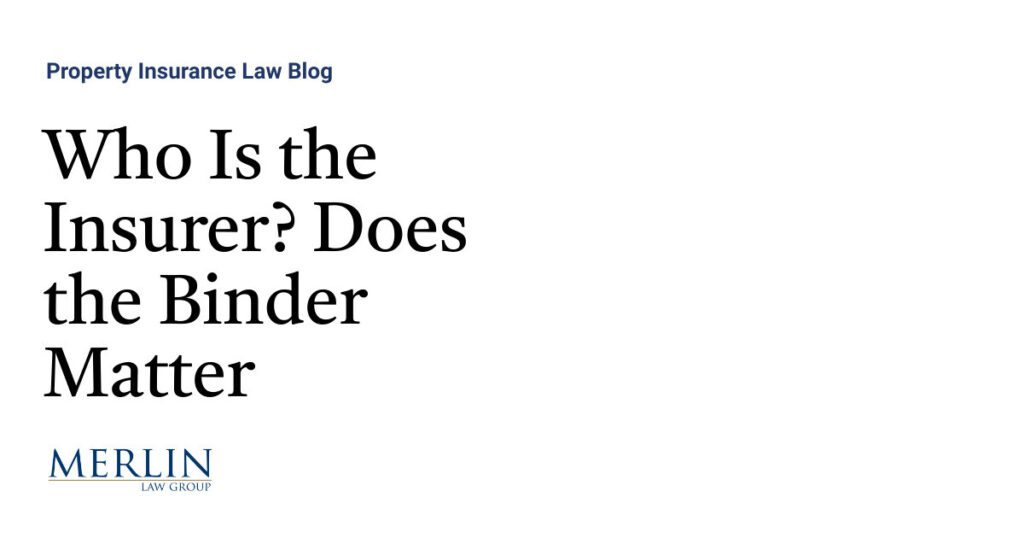Who Is the Insurer? Does the Binder Matter?

Insurance policies are like a box of chocolates—you never quite know what you’re going to get. Or, in the case of Billings Clinic v. Zurich American Insurance Company, 1 maybe you do, but the label on the box has you scratching your head. You might think Zurich American Insurance Company is the insurer after reading the binder and most of the policy, but then, almost like a hidden Easter egg, you find the actual insurer is its fully-owned subsidiary, American Guarantee and Liability Insurance Company (AGLIC). Let’s unravel this mystery.
The Binder That Binds—or Not?
Billings Clinic’s insurance policy journey began with a binder. Like a movie trailer that doesn’t match the final film, the binder heavily featured Zurich. References to “Zurich,” “Insurer,” and “We” made it seem like Zurich was the leading star. However, once the policy was issued, the plot twist emerged: AGLIC was the real insurer, with Zurich acting as more of a supporting character. The general adjuster assigned to the case was an employee of Zurich.
The court’s review in this case had to consider whether the binder or the policy ultimately dictated who was on the hook for the hailstorm damages. Billings Clinic pointed out that Zurich’s name appeared throughout the binder and the policy, right down to directing the insured to Zurich for complaint resolution. Zurich, however, argued that the binder was just a temporary placeholder until the policy took over. According to Zurich, the issued policy made it clear that AGLIC was the true insurer.
The court, much like an insurance archaeologist, sifted through the documents and concluded that the policy, as the final contract, superseded the binder. Under Montana law, a binder provides interim coverage but becomes irrelevant once the full policy is issued unless there’s ambiguity in the policy itself. And here, Zurich argued there was none—AGLIC’s name was right there in the very small fine print (albeit only once!). When I first looked at the policy, I missed its name.
The Effect of the Binder: State-by-State Drama
The impact of an insurance binder isn’t a one-size-fits-all scenario. States take different approaches to binders’ enforceability and their relationship to the final policy. For example, as noted in a prior analysis, Insurance Binders Can Form Insurance Coverage, binders can sometimes form the basis of coverage if the policy’s terms are unclear or not yet issued. In that post, I noted:
Insurance binders issued before a policy is sent to the policyholder can be major sources of disagreement regarding coverage. Most of these coverage controversies involve situations where the binder is issued shortly before a loss occurs.
In Montana, however, the binder is more of a prelude than a standalone act. Once the policy is issued, the binder’s role typically ends—unless the policy leaves unresolved questions.
The court declined to dismiss Zurich American Insurance Company (Zurich) from the case because there were unresolved factual disputes regarding Zurich’s role in the insurance policy and its relationship with the insured, Billings Clinic. Specifically, the court found that there was sufficient ambiguity in the documents—particularly in the binder and policy—to warrant further examination of whether Zurich acted as an insurer or was otherwise involved in the contractual obligations.
While Zurich argued that the full policy—naming AGLIC as the insurer—superseded the binder, Billings Clinic pointed out inconsistencies in the policy itself, which suggested Zurich’s involvement in the insurance relationship.
The court noted that the issue of whether Zurich was an actual party to the insurance agreement or whether its branding and representations created an apparent contract was a factual matter. Such disputes are generally not appropriate for resolution at the motion-to-dismiss stage, which tests the legal sufficiency of a complaint, not its factual accuracy.
What’s in a Name?
Zurich’s prominence throughout the binder and policy could easily lead a policyholder to believe they were dealing with Zurich as the insurer. But this case serves as a reminder that it’s not just the logos or branding that matters: What counts is what the policy explicitly says. With AGLIC’s name appearing only once in the policy, most people would understandably still think Zurich was the insurer. That disconnect highlights a potential pitfall for policyholders relying on assumptions rather than meticulously dissecting every page of their policy.
I am certain that virtually all policyholders would think their insurer is Zurich American. The policyholder was issued “The Zurich Edge Healthcare Policy.” Zurich North America advertises this policy follows:
The healthcare industry must confront an evolving landscape of risk that includes changing business models, technological innovations and regulatory reforms. These challenges can impact productivity, customer relationships and financial goals. Customized healthcare facility insurance solutions can help hospitals, clinics, physician medical offices, senior care centers, and other healthcare facilities, assess and mitigate these risks, allowing them to pursue their primary mission: delivering high-quality medical care.
Nowhere is the policyholder alerted that Zurich uses a bait and switch by having another company issue the policy before purchase. The only way to find that is to carefully dissect every line of the policy. The only adjuster was an employee of Zurich American Insurance Company.
Lessons Learned
This case offers a teachable moment for insurers and policyholders alike. Insurers might reconsider how their subsidiaries are branded and referenced in binders and policies to avoid confusion. For policyholders, it’s a cautionary tale to always verify who is legally obligated under their policy. As Billings Clinic learned, the devil—or, in this case, the insurer—is in the details.
So, who is the insurer? Sometimes, even the paperwork isn’t entirely sure.
Thought For The Day
“Details create the big picture.”
—Sanford I. Weill
1 Billings Clinic v. Zurich American Ins. Co., No. 1:24-cv-60, 2024 WL 4905440 (D. Mont. Nov. 27, 2024).



